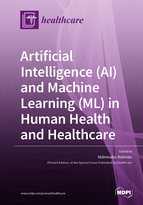Artificial Intelligence (AI) and Machine Learning (ML) in Human Health and Healthcare
A special issue of Healthcare (ISSN 2227-9032). This special issue belongs to the section "Artificial Intelligence in Medicine".
Deadline for manuscript submissions: closed (31 December 2021) | Viewed by 125916
Special Issue Editor
Interests: computer vision; image processing; information retrieval; machine learning; deep learning; classification, retrieval and interpretation of medical images; medical caption generation; explainable AI
Special Issues, Collections and Topics in MDPI journals
Special Issue Information
Dear Colleagues,
The ongoing innovations from the field of Artificial Intelligence (AI) and Machine Learning (ML) are playing a powerful role, influencing the lives of millions through health, safety, education, and other opportunities intended to be shared across all segments of society. In healthcare, AI is bringing a paradigm shift powered by the increasing availability of both structured and unstructured data and rapid development of big data analytic methods. These clinical data often exist in but are not limited to the form of demographics, medical notes, electronic recordings from medical devices (sensors), physical examinations, and clinical laboratory and images. Soon, it will be hard to imagine a doctor’s visit or a hospital stay that does not incorporate AI in numerous ways. It is poised to become a transformational force in which fear that AI will replace doctors and clinicians has gradually dissipated. ML algorithms are already allowing humans to gain unprecedented insights into diagnosing diseases based on histopathological examination or medical imaging, spotting malignant tumors in radiological images, detecting malignancy from photographs of skin lesions, discovering new drugs, finding treatment variability and patient outcomes, and also guiding researchers in how to construct cohorts for costly clinical trials.
Due to the unprecedented pandemic situation around the world, society has seen several recent and major breakthroughs in the healthcare and medicine field, such as COVID-19 vaccine discovery where ML-based techniques were massively favored to accelerate the design and production cycle of the vaccine in addition to enforcing effective social distancing and other preventive measures.
The ultimate goal of AI in healthcare is to re-humanize medicine by providing a set of tools to health professionals so that they can focus more on patient care by enabling the 4P model of medicine (predictive, preventive, personalized, and participatory) and therefore patient autonomy.
This Special Issue invites manuscripts (research, review, opinion, and case studies) on AI- and ML-based ongoing progress and related development to influence human health through healthcare systems, industry, technology, and ethical issues.
Research areas may include (but not be limited to) the following:
- AI/ML is precision medicine
- Neural networks and deep learning in healthcare
- Deep learning in electronic health record (HER)
- ML- and NLP-based understanding of clinical documentation
- Application of AI/ML in medical imaging
- AI-based clinical decision support system
- AI/ML-based screening systems
- AI therapy apps during the COVID-19 pandemic
- AI tools in telemedicine and telehealth
- ML for oncology-oriented image analysis
- Machine learning bias in healthcare
- Explainability for AI in healthcare
- Ethical, legal, and social implications of using AI system in healthcare
- The future of AI in healthcare
We look forward to receiving your contributions.
Dr. Mahmudur Rahman
Guest Editor
Manuscript Submission Information
Manuscripts should be submitted online at www.mdpi.com by registering and logging in to this website. Once you are registered, click here to go to the submission form. Manuscripts can be submitted until the deadline. All submissions that pass pre-check are peer-reviewed. Accepted papers will be published continuously in the journal (as soon as accepted) and will be listed together on the special issue website. Research articles, review articles as well as short communications are invited. For planned papers, a title and short abstract (about 100 words) can be sent to the Editorial Office for announcement on this website.
Submitted manuscripts should not have been published previously, nor be under consideration for publication elsewhere (except conference proceedings papers). All manuscripts are thoroughly refereed through a single-blind peer-review process. A guide for authors and other relevant information for submission of manuscripts is available on the Instructions for Authors page. Healthcare is an international peer-reviewed open access semimonthly journal published by MDPI.
Please visit the Instructions for Authors page before submitting a manuscript. The Article Processing Charge (APC) for publication in this open access journal is 2700 CHF (Swiss Francs). Submitted papers should be well formatted and use good English. Authors may use MDPI's English editing service prior to publication or during author revisions.
Keywords
- Artificial Intelligence (AI)
- Machine Learning (ML)
- Deep learning
- Medical imaging
- Electronic health record (EHR)
- Precision medicine
- Personalized healthcare
- Decision support system
- AI based screening system
- NLP in medicine
- ML bias







